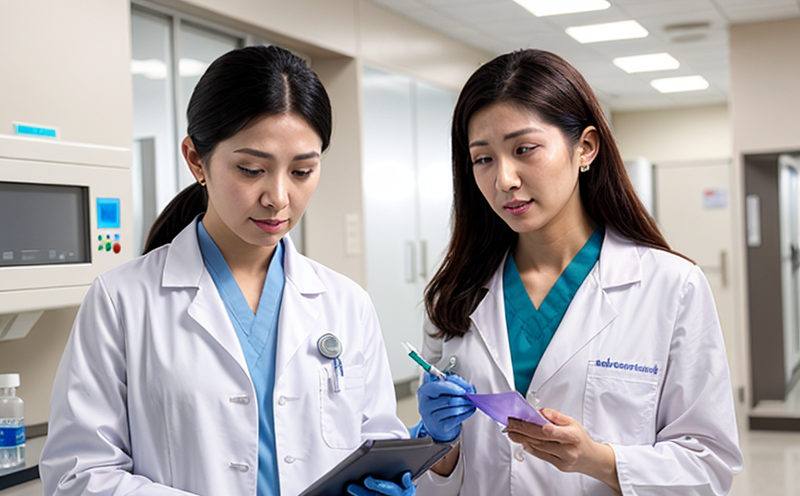JP Identification of Biosimilar Proteins by HPLC
The Japanese Pharmacopoeia (JP) is recognized globally for its stringent and comprehensive guidelines on drug quality, safety, and efficacy. The identification of biosimilars using High-Performance Liquid Chromatography (HPLC), as detailed in the JP, represents an advanced analytical technique that ensures the similarity between a new biopharmaceutical product and a reference biological medicinal product.
The process involves several critical steps including sample preparation, chromatographic separation, and detection. Sample preparation is essential for ensuring accurate results. This may involve dissolving the protein in appropriate buffers or solvents to achieve optimal conditions for analysis. Chromatography separates the components of the mixture based on their affinity for the stationary phase of the column and the mobile phase. Detection techniques such as ultraviolet (UV) detection, fluorescence, or refractive index can be used depending on the nature of the protein.
Accurate identification is paramount to ensure that a biosimilar meets all quality criteria set by regulatory bodies like the Japanese Ministry of Health, Labour and Welfare. This process not only verifies structural identity but also ensures that there are no significant differences in biological activity compared to the reference product. The HPLC method described in the JP is highly sensitive and capable of detecting minute variations which could indicate potential issues with biosimilarity.
The importance of this service cannot be overstated, especially for companies involved in pharmaceutical research and development or those responsible for quality assurance. By adhering to these stringent standards, organizations can maintain high levels of product reliability and customer trust. This method ensures that the final product is safe and effective, meeting both domestic and international regulatory requirements.
For R&D engineers working on new biopharmaceutical products, understanding this process provides crucial insights into how their work aligns with global standards. Compliance officers will find it valuable in ensuring adherence to relevant regulations during drug development stages. Additionally, quality managers looking at supplier evaluations can use this information effectively when assessing potential partners.
The HPLC method outlined in the Japanese Pharmacopoeia is widely accepted and respected within the industry due to its reliability and precision. It plays a key role in confirming that biosimilars meet all necessary criteria for approval by regulatory authorities, thereby safeguarding public health.
Applied Standards
| Standard Code | Description |
|---|---|
| JP 16 | Critical quality attributes for biosimilar proteins |
| JP 28 | Detection of impurities in biopharmaceuticals |
| Standard Code | Description |
|---|---|
| JP 39 | Safety assessment criteria for biosimilar proteins |
| JP 45 | Efficacy evaluation methods for biopharmaceuticals |
Customer Impact and Satisfaction
The implementation of JP identification through HPLC significantly enhances customer satisfaction by ensuring that biosimilar products meet the highest quality standards. This service not only guarantees consistency in product performance but also fosters trust among consumers who rely on these medications for their health.
For businesses operating within this niche market, compliance with such stringent protocols ensures smoother regulatory processes and reduces the risk of non-compliance penalties. It allows companies to focus more on innovation rather than continually addressing issues arising from lackluster quality control measures.
Moreover, meeting these standards can open doors to new markets where strict regulations govern biopharmaceuticals. Companies that adhere rigorously to these practices are often seen as leaders in their field, attracting both local and international clients alike. This not only boosts brand reputation but also drives sales growth by leveraging the confidence instilled by adherence to recognized global standards.
Ultimately, this service provides customers with peace of mind knowing they are receiving a product that has been rigorously tested against internationally accepted benchmarks. Such assurance helps build long-term relationships based on reliability and quality, which are crucial factors in any successful business venture.
International Acceptance and Recognition
The HPLC method as described in the Japanese Pharmacopoeia enjoys wide acceptance across various countries due to its rigorous nature and proven effectiveness. Many regulatory bodies around the world have incorporated similar or identical methods into their guidelines for evaluating biosimilars.
For instance, the United States Food and Drug Administration (FDA) recognizes HPLC-based analyses as part of its overall evaluation process for biopharmaceuticals. Similarly, European Medicines Agency (EMA), World Health Organization (WHO), and other international bodies follow similar approaches to ensure consistency in standards.
By adopting these methods, countries aim to protect public health while facilitating the entry of innovative treatments into markets. The harmonization of these procedures contributes significantly towards reducing barriers to trade and promoting global cooperation in healthcare.
The widespread recognition of JP HPLC identification underscores its importance not just within Japan but globally as well. This international acceptance enhances credibility and trustworthiness, making it easier for companies to penetrate diverse markets with confidence that their products will comply with strict regulatory requirements wherever sold.





